The AMD Ryzen 5 1600X vs Core i5 Review: Twelve Threads vs Four at $250
by Ian Cutress on April 11, 2017 9:00 AM ESTBenchmarking Performance: CPU Web Tests
One of the issues when running web-based tests is the nature of modern browsers to automatically install updates. This means any sustained period of benchmarking will invariably fall foul of the 'it's updated beyond the state of comparison' rule, especially when browsers will update if you give them half a second to think about it. Despite this, we were able to find a series of commands to create an un-updatable version of Chrome 56 for our 2017 test suite. While this means we might not be on the bleeding edge of the latest browser, it makes the scores between CPUs comparable.
SunSpider 1.0.2 [link]
The oldest web-based benchmark in this portion of our test is SunSpider. This is a very basic javascript algorithm tool, and ends up being more a measure of IPC and latency than anything else, with most high performance CPUs scoring around about the same. The basic test is looped 10 times and the average taken. We run the basic test 4 times.
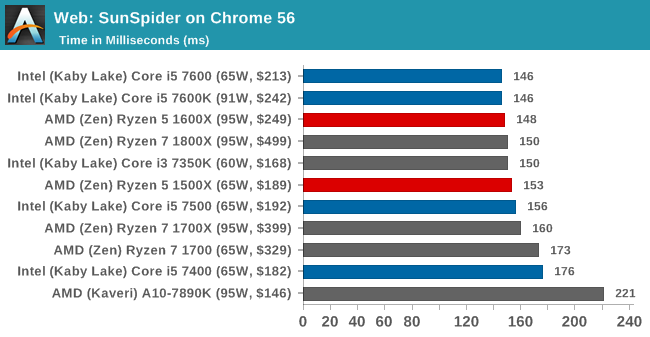
Mozilla Kraken 1.1 [link]
Kraken is another Javascript based benchmark, using the same test harness as SunSpider, but focusing on more stringent real-world use cases and libraries, such as audio processing and image filters. Again, the basic test is looped ten times, and we run the basic test four times.
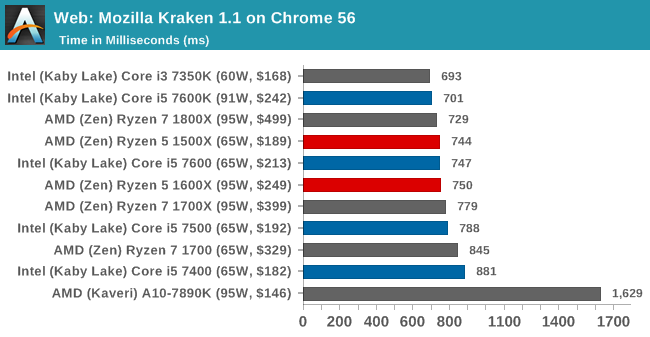
Google Octane 2.0 [link]
Along with Mozilla, as Google is a major browser developer, having peak JS performance is typically a critical asset when comparing against the other OS developers. In the same way that SunSpider is a very early JS benchmark, and Kraken is a bit newer, Octane aims to be more relevant to real workloads, especially in power constrained devices such as smartphones and tablets.
WebXPRT 2013 and 2015 [link]
While the previous three benchmarks do calculations in the background and represent a score, WebXPRT is designed to be a better interpretation of visual workloads that a professional user might have, such as browser based applications, graphing, image editing, sort/analysis, scientific analysis and financial tools. Web2013 is the older tool, superceded by Web2015, however both still are highly relevant for high-performance web applications today.
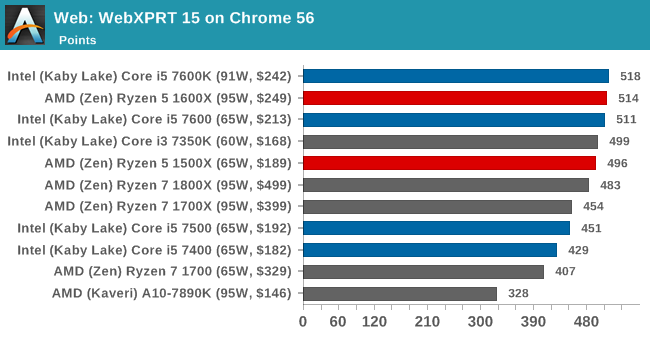


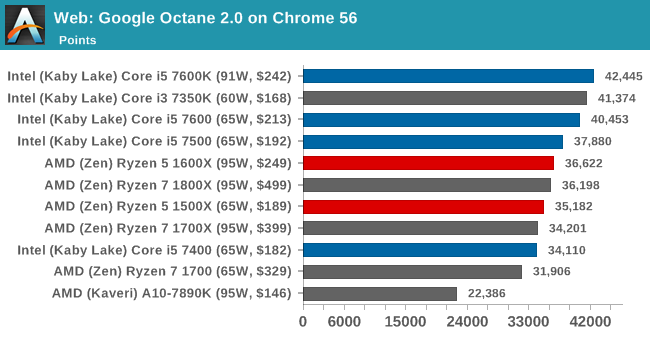
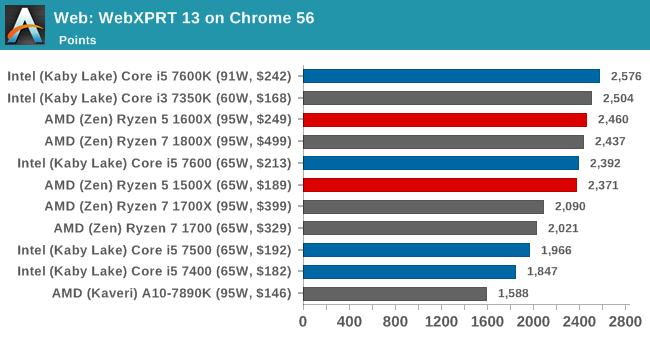








254 Comments
View All Comments
Icehawk - Tuesday, April 11, 2017 - link
Good point, my company isn't going to spend more for an AMD system for our regular users and a video card (even junk) would likely tip the cost against them. I do think some of our devs might like these and there we can justify the extra $.Krysto - Wednesday, April 12, 2017 - link
Ryzen APUs are coming.deltaFx2 - Tuesday, April 11, 2017 - link
@jrs77: Talk about strawman arguments. "as the most used software is still singlethreaded " Just because you vehemently assert it doesn't make it true. All the MT workloads tested in Ian's suite are real workloads people use. I have 14 "Chrome Helper" threads running on my laptop as I type this, just to point out the obvious. The software that continues to be single threaded are the ones in which the cost of a MT implementation outstrips the gain. Office is 1T (I'll take your word for it) because it works perfectly fine on Atom or Excavator. I don't think Photoshop is a workload that holds up people most of the time either. Here's the other thing: Folks who have Photoshop for a living also likely do video editing, rendering and so forth. Sometimes at the same time as photoshop. See Ian's review of various workloads that do this.iGPU: That is fair point for the 4c part. For the hex-core, you're getting into the same usage space as the 8c: content creators. Then again, who buys desktops these days for office work? Most offices I know of give their employees laptops + docking stations. It's only gamers and content creators, CAD folks that buy laptops. These guys also buy graphics cards to go with their rig.
psychobriggsy - Wednesday, April 12, 2017 - link
One benchmark that used to be done was multiple apps at the same time.For example, a browser benchmark running alongside a video encode.
This can show real world use cases a lot better. Also it would show off better MT implementations better, in this case Ryzen would fare a lot better (either by having SMT in the 4C8T, or have more cores and SMT in the 6C12T) even where the Intel equivalent would do okay when doing 1 task only.
masouth - Wednesday, April 12, 2017 - link
to add onto that, even certain tools/ functions in Photoshop are multi-threaded. Most blurs are as well as color mode conversions just to name a couple.as usual, YMMV depending on how often you use those but it IS there and more cores/threads offers a very real benefit for people that do use them.
Meteor2 - Wednesday, April 12, 2017 - link
Most users could easily get by with Celerons. I'm not sure what your point is.ChubChub - Tuesday, April 11, 2017 - link
At $250 what should you get? A 1400, and use the extra cash + saved cash on the motherboard to get a better GPU.davide445 - Tuesday, April 11, 2017 - link
1600x or 1600 will be part of my new rig.Really clear from this review AMD does optimize his CPU for serious tasks (where lie the real lasting grow in the PC market) and modern gaming titles (DX12, the future), leaving a sufficient to good performance to the others.
Minimizing production costs can profit for sales and sustain Intel possible dumping activities.
IMHO a clever strategy, since they didn't need to serve ALL the market, but just being able to lead the most profitable, that's for sure not the casual e-Sport gamer.
ImperfectLink - Tuesday, April 11, 2017 - link
Cinebench 10 and 11.5 tables are mixed up. It's 11.5 first with the decimals and 10 with the thousands.farmergann - Tuesday, April 11, 2017 - link
You choose to finish the article with, "...the Intel CPU is still a win here." A sentence that simply doesn't belong in any Ryzen vs sky/kaby comparison, much less as the final statement. What a joke of a shill you must be. BTW, your own testing reveals that tasks and games truly dependent on single thread IPC find Broadwel DT the victor over newer intel garbage, yet you mention Broadwell here as though it were dated... pitiful.